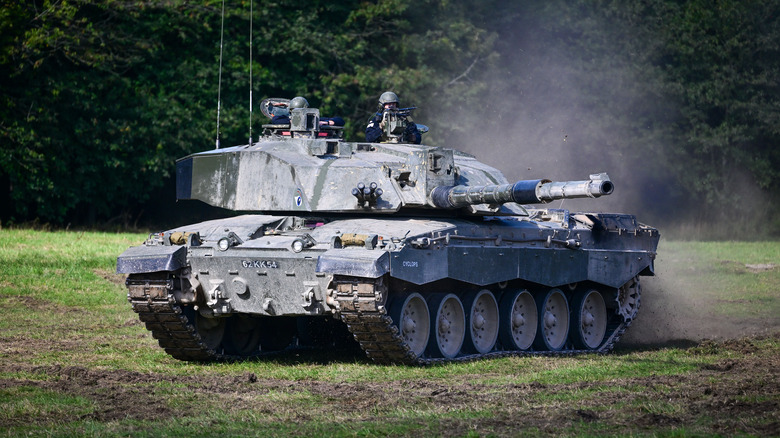
Finnbarr Webster/Getty Images
By their very nature, tanks are heavy. After all, they are armored vehicles that often have inches of hardened armor to protect those inside and huge main guns that are capable of destroying other tanks (or almost anything else in their way). Since their introduction a century ago, tanks have played an essential role in warfare, and their designs are often a compromise between firepower and armor against maneuverability and mobility.
That means that many tanks are not only very expensive to build but also incredibly heavy, especially if the aim for the tank isn’t for it to move around at high speed. With so much hardware to fit into the vehicles, ranging from massive engines to fire control systems and ammunition, even modern tanks can weigh several dozen tons. Here, we are going to look at the heaviest tanks ever built, all the way from the First World War to the modern era.
For this article, we’ve listed all tank weights in metric tons, which is equivalent to 1000 kilograms or 2204 pounds. This is to avoid confusion with short and long tons that are often used. We’ve also limited our scope to tanks that had units or working prototypes built, although they may not necessarily have entered active service.
K2 Black Panther — 55 tons
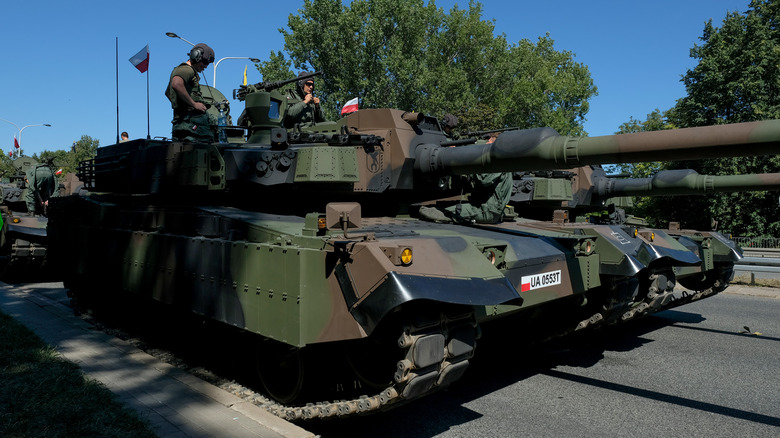
Bloomberg/Getty Images
The K2 Black Panther is a recent addition to the world of main battle tanks. Built for the South Korean military, it only entered service in 2014 after some 10 years of development. Due to the threat posed by North Korea and its allies, the tank is designed to be highly mobile so that it can strike hard and fast. This has made it attractive to other nations, with Turkey and Romania showing interest in the design.
Like many modern main battle tanks, the K2 Black Panther comes equipped with a 120-millimeter L/55 smoothbore gun. Its Tognum MT 833 diesel engine allows it to reach top speeds of up to 42 miles per hour on smooth terrain. Thanks to its advanced fire control system, which allows it to target and fire on enemy units that are up to six miles away, and its smart network features for sharing information, the tank is among the most expensive on the planet with an estimated price of $8.5 million.
In many ways, the K2 Black Panther is very similar to the M1 Abrams. This is perhaps due to the close relationship South Korea shares with the United States. However, the K2 is significantly lighter than its counterparts, despite featuring modular composite and Explosive Reactive Armor, and weighs just 55 tons.
M103 heavy tank — 62 tons
While the most famous tank to serve in the U.S. military is undoubtedly the M1 Abrams, American forces had another workhorse that predated it by almost two decades. The M103 is a heavy tank, a classification of vehicle that includes tanks that were produced during World War I and continued to be used through the Cold War. These tanks became popular in the Second World War because their increased firepower made them a bigger threat on the battlefield, while the heavier, thickened steel armor protected them from most forms of attack.
However, they eventually fell out of favor when advances in technology meant that medium tanks could have similar levels of protection and firepower in a far more maneuverable form. That’s the fate of the M103, which was ultimately replaced by the superior M1 Abrams. That didn’t stop it from being an effective tool while it was in operation, though, and around 300 of them were produced between 1957 and 1974. Manufactured by Chrysler, the tank had a total weight of 62 tons and was both longer and wider than the M1 Abrams.
Much of that weight came from the impressive 120mm M58 main gun and up to five inches of steel armor at the forward position. The M103 also came equipped with an M89 turret for close-quarters combat but was limited by its top speed of just 21 miles per hour and its range of less than 100 miles. As it never saw active combat, it is not possible to know exactly how effective this tank was, yet there’s no denying it was one of the heaviest ever built.
Leopard 2 — 64.5 to 67 tons
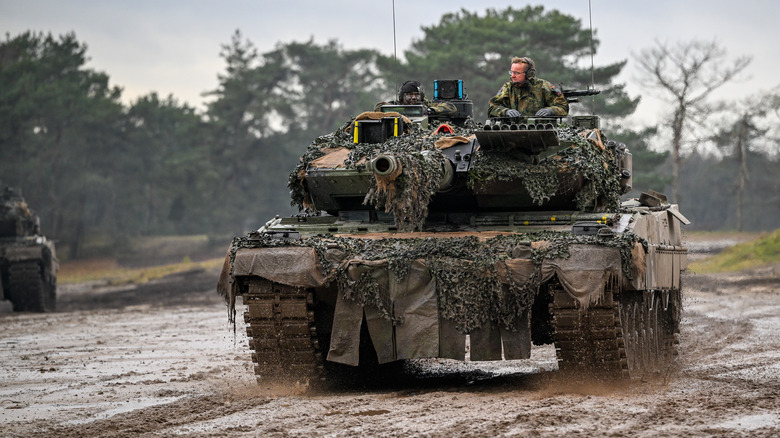
Sascha Schuermann/Getty Images
Among the most expensive and widely used main battle tanks in the world, the Leopard 2 is a German-made tank that was first introduced in 1979 and has since gone on to become the backbone of more than a dozen nations’ military forces. A third-generation tank, it is Germany’s equivalent of the Challenger II and M1 Abrams, and has seen more than 3,600 units produced over the last 40 years. The Leopard 2’s versatility, maneuverability, and advanced technology makes it a standout tank, with the most recent models costing in the region of $30 million each.
Standard Leopard 2 tanks feature a 120mm main cannon, two 7.62mm machine guns, and a 1,500-horsepower engine that allows the tank to reach a top speed of 42 miles per hour. In terms of armor, the German tank boasts modular armor that includes hardened steel, tungsten, and titanium to ensure it can withstand direct hits. The current Leopard 2A7V model has a weight of around 64.5 tons. However, the sheer number of different models means that there is a wide range of weights for each variant of the Leopard 2. For example, the upcoming Leopard 2A8 will have an operation weight of between 65 and 67 tons.
Tiger II — 68 tons
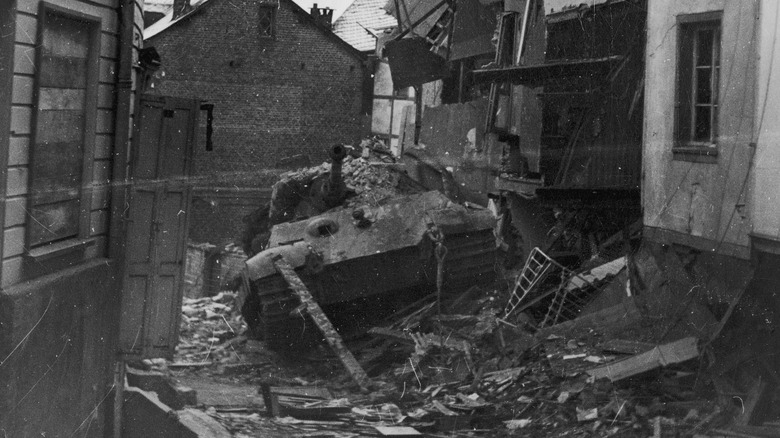
Allan Jackson/Getty Images
Going by many names, the Tiger II is a German heavy tank that was designed in 1943 and entered active service the following year. Less than 500 were created, despite an order of more than 1,500 from Germany’s high command, due to British RAF bombing campaigns that severely damaged facilities responsible for manufacturing the tank. A successor to the Tiger I, this new tank was more mobile than its predecessor and also included a number of notable improvements, including more effective sloping armor and a more powerful engine.
The need for a heavier and better-protected tank led to the Tiger II weighing significantly more than the Tiger I, with a mass of 68 tons. Much of that weight was due to the newly produced 88mm KwK 43 main gun (which gave the tank a maximum firing range of around 6 miles and allowed it to effectively take down opposing tanks) and six-inch thick armor to defend it from incoming attack.
The Tiger II played an important role at the Normandy landings and was arguably the most deadly tank that was in active operation at that stage of the war. Manned by a crew of five individuals, the Tiger II had a top speed of just under 26 miles per hour and could travel cross-country at more than 12 miles per hour.
M1 Abrams — 71.2 tons
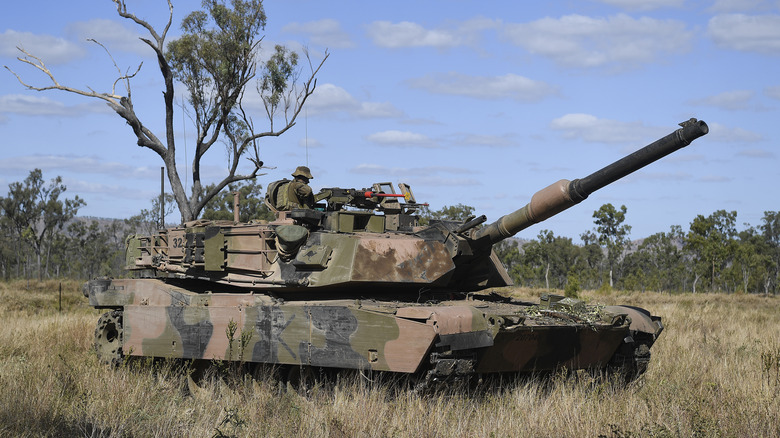
Ian Hitchcock/Getty Images
Wherever the U.S. Army has fought over the last four decades, the M1 Abrams has steadfastly provided armored support. The main battle tank has proven to be an incredible success story; there have been approximately 10,000 produced since they were first introduced in 1980. Named after General Creighton W. Abrams, the tank has gone through dozens of revisions over the years, with the M1A2 SEP Abrams being the most recent version.
Costing over $10 million per unit, the M1 Abrams is not only one of the heaviest tanks ever created but also among the most expensive. The most widely used tank across the globe, it has seen action in Iraq, Afghanistan, and Yemen, and is used by the militaries of such countries as Australia, Egypt, and Saudi Arabia.
The tank now comes fitted with a 120 mm L/44 M256 smoothbore gun (but has previously been equipped with a 105 mm L/52 M68A1 rifled gun), has a 1,500-horsepower engine, and can reach a top speed of 42 miles per hour. The M1A2 SEP also features graphite-coated armor and the Trophy active protection system, adding further defensive capabilities. This variant weighs a total of 71.2 tons, up from the 60-ton weight of the original model.
Challenger 2 — 75 tons
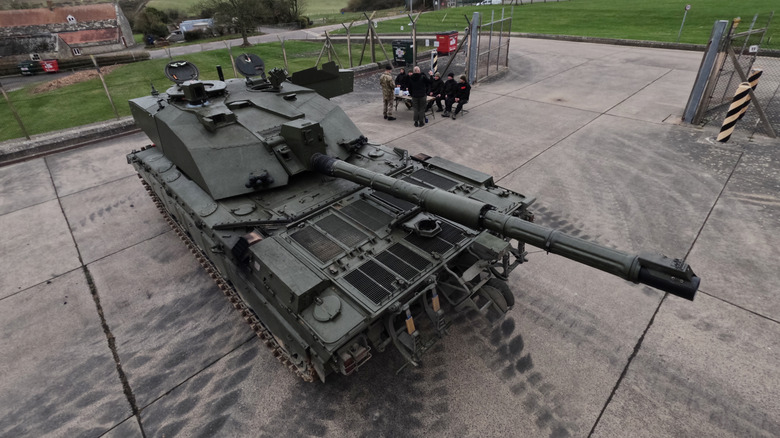
Leon Neal/Getty Images
The Challenger 2 has become one of the most reliable and versatile main battle tanks of recent times. Essentially, it is the UK’s answer to the M1 Abrams and the Leopard 2, and it first entered service in 1994. Since then, it has become the mainstay of the British Army and it is also used by the Oman military and Ukraine in its defensive efforts against Russia. The innovative Dorchester 2 armor provides it with plenty of protection against anti-tank weaponry, while the powerful 120mm L30 rifled gun gives the tank its main form of attack. There’s also two 7.62mm chain guns to provide close protection from infantry attack.
Costing around $5 million to produce, the Challenger 2 is capable of reaching top speeds of 37 miles per hour and requires a crew of four to operate it. Around 400 of them have been built since 1998, and it is an incredibly successful vehicle. It was only in 2023 that a Challenger 2 tank was destroyed by enemy forces, with previous losses coming only due to friendly fire. Typically, the Challenger 2 only weighs around 64 tons; still a heavy vehicle but not quite as massive as other tanks. However, the tank can be outfitted with a number of optional armor modules to provide extra protection, and some of these can take the overall mass to 75 tons.
Char 2C — 69 to 77 tons
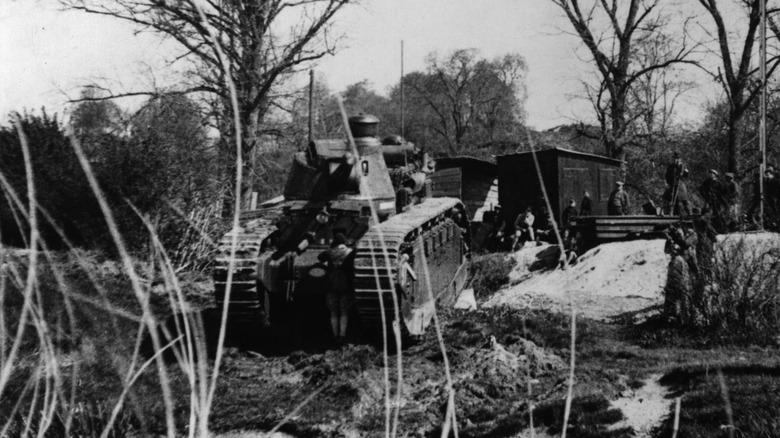
Topical Press Agency/Getty Images
Many of the heaviest tanks come from the era of the First and Second World Wars. This was a time when tanks first entered service, and designers were constantly looking to improve them to make them more effective machines of war. Yet, the technology of the day often meant that these tanks were limited in terms of their mobility and weight, especially when they were intended to be heavily fortified and use incredibly powerful weapons. That was certainly the case with the French-made Char 2C, a super-heavy tank that was created with the intention of being larger and heavier than any other tank of the era.
Design for the Char 2C began during the First World War but wouldn’t be completed until 1921 when it first entered service. However, the vehicle saw little action and they were intentionally destroyed when Nazi Germany invaded France during the Second World War to prevent them from being captured and used against the French. Just 10 of these behemoths were put into service and they were mainly seen as a propaganda effort to keep the French population content after the success of British and German tanks during the First World War.
While other tanks have been heavier than the Char 2C, it is considered to be the heaviest of those that were in operation and were not mere prototypes. While there is some debate over their exact weight, estimates suggest that it is anywhere between 69 tons and 77 tons. That makes sense considering the huge size of the Char 2C, which was more than 33 feet long and required a crew of 12 to run.
Tortoise heavy assault tank — 79 tons
World War II posed many challenges for the Allied forces. Germany had built up extensive fortifications during the war and in the run-up to the start of the conflict, with the Atlantic Wall and Siegfried Line being two of the most famous examples. Even the most powerful tanks and gun platforms would pose little threat to these heavily fortified positions as they often included devastating weapons, bunkers, and strong barriers. With an invasion of Europe from the UK necessary to defeat German forces, plans were put in place to create tanks that would be able to destroy such fortifications and allow Allied troops to break through.
The Tortoise heavy assault tank was the result of these plans, although production only began near the end of the Second World War and they never had the chance to enter active service. With the war concluded and hostilities over, in addition to newer designs being commissioned for future tanks, the Tortoise heavy assault tank was shelved after just six of them had been fully constructed.
The purpose of the tank, though, meant that those that were created were incredibly heavy and large. To withstand enemy fire from fortified positions, the Tortoise heavy assault tank had armor that was up to nine inches thick. It came equipped with an Ordnance QF 32-pounder 94mm gun capable of easily penetrating German tanks, along with several machine gun turrets. At 79 tons, the tank was only able to travel at a top speed of 12 miles per hour.
T28 Super Heavy Tank — 95 tons
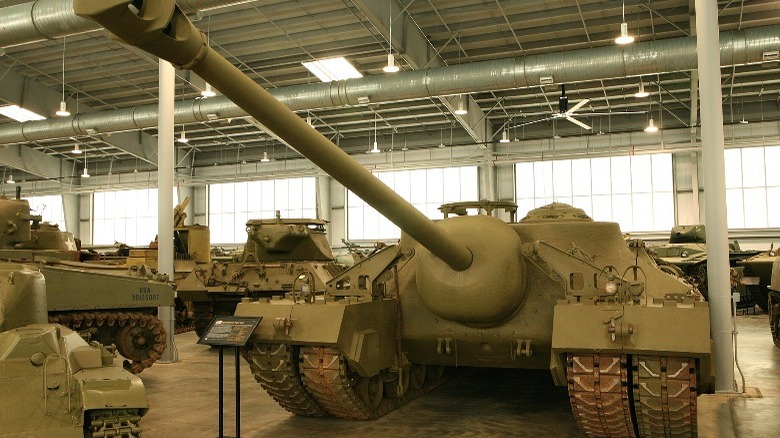
Schierbecker/Wikipedia
With many nations constructing super-heavy tanks during both World Wars, including the French Char 2C and the British Tortoise heavy assault tank, it became necessary for the U.S. to develop its own model to ensure it wouldn’t be left behind. The T28 Super Heavy Tank was designed for much the same purpose as the Tortoise heavy assault tank: to break through fortified positions such as the Siegfried Line. To do so, it needed to be both heavily armed and armored.
Crewed by a team of four, the T28 was over 36 feet long and almost 15 feet wide, with a top speed of eight miles per hour. The first designs for the vehicle came in 1944, with production starting in 1945. Like its British counterpart, by the time the first two models were completed, the need for these super heavy assault tanks had gone, as Allied troops had successfully invaded Europe and reached Germany. Production was quickly canceled in favor of more conventional tank designs.
With armor that reached a maximum thickness of up to 12 inches and a 105mm T5E1 gun that had a muzzle velocity of 3,500 feet per second, the T28 was the largest tank the U.S. Army had ever constructed at the time and weighed a staggering 95 tons. This massive weight was one of the reasons that the T28 project was ultimately shelved, as it made it impractical to transport.
[Featured image by Schierbecker via Wikimedia Commons | Cropped and scaled | CC BY-SA 4.0]
Panzer VIII Maus — 188 tons
Of all the tanks that have ever actually been built, the Panzer VIII Maus is easily the largest and heaviest. In fact, it is almost twice as heavy as the next contender and dwarfs almost every other tank that was ever constructed. Development on the project began in 1941, with Hitler determined to field a tank that was bigger and more powerful than any of those wielded by Allied forces. The end result of this was the Panzer VIII Maus, which was put into production in 1944.
Unfortunately for Hitler, he never got to see the Panzer VIII Maus in action. Only two models of the tank were ever completed and, of those, only one had a functioning gun turret fitted. The vehicle was involved in testing when Allied and Soviet troops were nearing Germany. In fact, Soviet forces captured the only two versions of the Panzer VIII Maus that had been built just three weeks before Germany surrendered.
Unlike most guns on tanks, this vehicle sported a 128mm KwK 44 gun L/55. This was effectively an anti-tank artillery armament that was incredibly heavy on its own and was able to destroy any opposing armored vehicle of the time. Throw in the thick armor — which measured between six and nine inches — and the massive engine needed to power the tank, and it quickly becomes clear why the Panzer VIII Maus was so heavy at 188 tons.